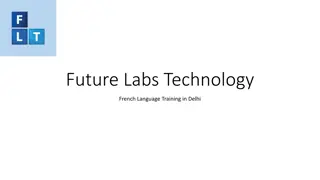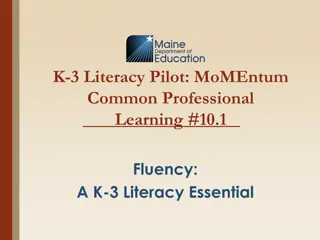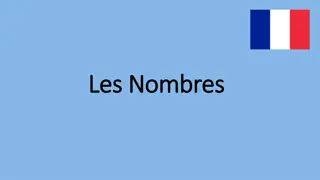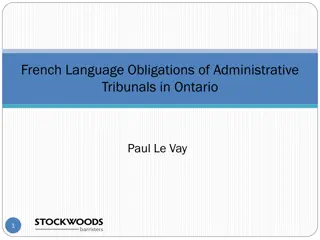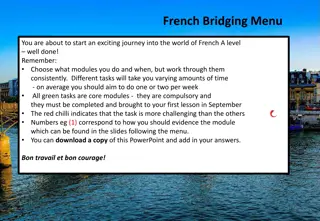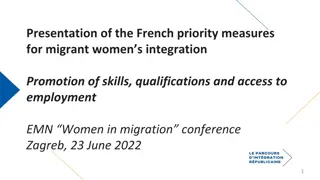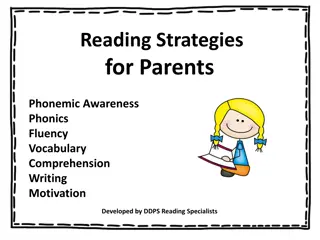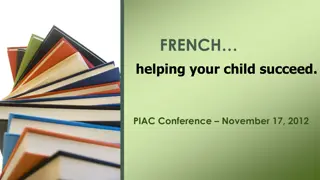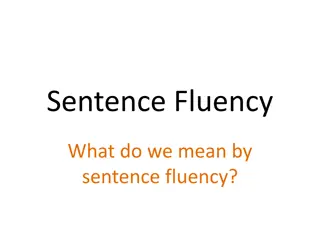Challenges and Strategies in Promoting French Language Fluency Among Boys in Education
This content discusses the challenges faced in encouraging boys to speak French and stay in French immersion programs, highlighting factors such as academic difficulties, cultural stereotypes, and limited course choices. It also explores the importance of male role models and motivation in promoting French language learning among boys. Strategies to address these issues include increasing the value of French, involving male role models, and fostering a positive school culture towards French education.
Download Presentation

Please find below an Image/Link to download the presentation.
The content on the website is provided AS IS for your information and personal use only. It may not be sold, licensed, or shared on other websites without obtaining consent from the author.If you encounter any issues during the download, it is possible that the publisher has removed the file from their server.
You are allowed to download the files provided on this website for personal or commercial use, subject to the condition that they are used lawfully. All files are the property of their respective owners.
The content on the website is provided AS IS for your information and personal use only. It may not be sold, licensed, or shared on other websites without obtaining consent from the author.
E N D
Presentation Transcript
https://reseauinternational.net/francais-langue-parlee-en-2050/https://reseauinternational.net/francais-langue-parlee-en-2050/
Et Les garons ? Boys in French Immersion Gloria Lowe LLED 590
Who am I? Gloria Lowe BEd (secondary math and French) UVic MEd (Modern Languages) UBC 30 years teaching grades 8 12 Core French French Mathematics French Immersion oFran ais Langue oMath matiques oCuisine oArts Visuels oTourisme oArts Dramatiques o tudes Ind pendantes
I Dont want to be in French anymore ! Academic Difficulties Quality of Teaching Parental Influence Limited choice of courses Peer Pressure Work load (Bartram, 2006; CPF, 2004;Nieswandt & Shanahan, 2008).
School Culture Boys want to be cool (respected by peers). Cultural stereotype: Boys like math, science, shop and outdoor Ed. Only girls like French. If you drop French, you can Take all of the sciences Get into better university programs (Bartram, 2006; Callaghan, 1998; Clark & Burke, 2012; Kissau, 2006; Kissau, 2007; Makropoulos, 2010)
Subjects of interest What is offered in French ? Sciences Humaines Fran ais Langue What about? Physical Education Outdoor Education Shop Cuisine Technology Art
Personal Reflection a) Who in my school encourage boys to speak French? stay in French? value French? b) c) d) How? How do I ??? Is French cool in my school? ?
Male Role Models If French is for boys, why are all of the adult French speakers women . ? Moniteurs (Federal grants) Librarians Tutors Community members Senior students twinning projects Initiative to encourage boys to become leaders (Brozo, 2006; Clarke & Burke, 2012; Power of Maroon, 2010)
Motivation People can be motivated because they value an activity or because there is strong external coercion. They can be urged into action by an abiding interest or by a bribe. They can behave from a sense of personal commitment to excel or from fear of being surveilled. (Deci & Ryan, 1985, p. 69)
Motivation: Intrinsic vs extrinsic? Students who are intrinsically motivated Retain learning longer Are more likely to continue learning outside of school Participate willingly without rewards (Deci & Ryan, 1985; Nicholson, 2013; Nieswandt & Shanahan, 2008)
Do we unintentionally undermine intrinsic motivation? Threats of punishment Pressured deadlines High stakes evaluation Extrinsic rewards o letter grade o 2 sheets of paper at graduation rather than 1 o better job 10 years from now o approval from a teacher (Deci & Ryan, 1985)
Can we create intrinsic motivation ? if educators invested a fraction of the energy on stimulating the students' enjoyment of learning that they now spend in trying to transmit information we could achieve much better results. Literacy, numeracy, or indeed any other subject matter will be mastered more readily and more thoroughly when the student becomes able to derive intrinsic rewards from learning. (Csikszentmihalyi, 1990, p. 115)
Autonomy Perception of autonomy on Day 1 Choice Choosing to speak French Choosing how to meet learning outcomes Choosing how to show learning (Blair & Sanford, 2004; Chan, 2016; Clarke & Burke, 2012; Hafen, 2010; MacIntyre et al., 2011; Nicholson, 2016)
Humour Boys become more engaged when there is humour. being serious all of the time is boring Their sense of humour might be different than yours. Your sense of humour is important! (Huth, 2005; Reichert & Hawley, 2014; http://www.allocine.fr/film/fichefilm _gen_cfilm=56143.html)
Have to Move Boys learn best when they get to move around. How can we bring movement into our activities? (Blair & Sanford, 2004: Sanford, 2006; LaPorte, 2006; Royer, 2010) http://worldartsme.com/boy-sitting-clipart.html
50 / 50 draw Pick your team by popsicle stick (random grouping activity) Share an activity from your class that gets students up, moving, and communicating in class. Be ready to share one of these ideas with the class ! Asking for volunteers in a fun way (50/50 draw)
Cooperative Learning Skits or role plays Penser-discuter en paires-partager (Think Pair Share) Jigsaws Activities and games : Negotiate tasks in order to achieve a goal Find people that fit a certain description Surveys (Shrum & Glisan, 2016)
Topics of Study relevant and interesting vehicles Hollywood music bikes fashion current events Science home sports emotions travel sports stars description (Blair & Sanford, 2004; Callaghan, 1998; Laporte, 2006; McCall, 2011)
Technology Enhance Presentations and projects Wevideo Prezi Use online games to enhance flow. MyJeopardyLabs Kahoot
Flow Loop model (HSI, 2013, p.7)
Un homme, un vrai, ne perd pas son temps avec des livres. Il r pare des voitures, bricole dans son atelier, compte des buts au hockey ou plaque des adversaires au football. (Bock-C t , 2017, para.14) Round-table discussion Image: https://www.amazon.ca/Reading-Dont-Fix-No-Chevys Reading
Ideas for novels that my junior boys like http://www.renaud-bray.com What?
Why are we doing this ? Relevant Challenging Motivating What is the point of them reading this particular text? What are they going to do with it? Boys want lessons with transitivity. (Cartier, 2007; Clark & Burke, 2012; Riechert & Hawley, 2010)
Activity idea Affiche Recherche Criminel Relevant Challenging Motivating Clear Purpose Movement & Collaboration (Cartier, 2007; Clark & Burke, 2012) https://www.wakfu.com/fr/for um/137-histoires-jeu-role
Activity idea Les enjeux de la voie Camillien-Houde repenser Exploration virtuelle Pr parer un d bat (Cartier, 2007; Clark & Burke, 2012) https://www.ledevoir.com/societe/transpo rts-urbanisme/520603/voie-camillien- houde-les-enjeux-d-une-voie-a-repenser
Print or Online Instructions models? recipes map Classified Ads Horoscopes Magazine articles Newspapers Blogs Product reviews (bikes, skis, etc) (Conradi, 2013)
Personal Reflection (Be honest !!) Do you a) Notice boys misbehaving more than girls? b) Put a boy in a position of leadership? ? c) What can I change - one behaviour ? (Callaghan, 1998; Royer, 2010; Sanford, 2006)
Boys learn best from teachers who are dynamic Move around Provide student centered lessons Are relaxed and can joke with students (Laporte, 2006)
Boys learn best from teachers who are knowledgeable Clear Organized Set high but attainable goals Clear consistent feedback on how to improve ISBN-13: 978-1612506647 ISBN-10: 161250664X (Reichert & Hawley, 2009/2010; Reichert & Hawley , 2014)
Boys learn best from teachers who Genuinely care about them and their interests Don t give up when trying to establish a relationship. Are willing to compromise their rules and expectations in order to value efforts made by the students. Boys are relational learners. Establishing an affective relationship is a precondition to successful. (Riechert & Hawley, 2009/2010, p. 38)
In summary Make an effort to get to know the boys Earn their respect by being competent and knowledgeable Provide lessons involving movement and time for sharing with peers Involve technology as much as possible Provide activities that encourage a flow experience Create learning that is relevant and useful to them. If it is not useful don t do it!
For a copy of the resources generated gloria.lowe@sd6.bc.ca
References Bartram, B. (2006). An examination of perceptions of parental influence on attitudes to language learning. Educational research, 48(2), 211-221. http://dx.doi.org/10.1080/00131880600732298 Blair, H. A., & Sanford, K. (2004). Morphing literacy: Boys reshaping their school-based literacy practices. Language Arts, 81(1), 452-460. Retrieved from http://isu468research.wikispaces.com/file/view/morphing+literacy-blair.pdf Bock-C t , M. (2017). Des Gar ons Incultes. Retrieved from http://www.journaldemontreal.com/2016/11/17/des-garcons-incultes Brozo, W. (2006). Bridges to literacy for boys. Educational Leadership, 6, 71-74. Retrieved from https://www.researchgate.net/publication/ 288272630_Bridges_to_literacy_for_boys Brozo, W. G. (2017). Disciplinary and Content Literacy for Today s Adolescents: Honoring Diversity and Building Competence. Retrieved from https://books.google.ca/books
References Callaghan, M. (1998). An investigation into the causes of boys underachievement in French. The Language Learning Journal, 17(1), 2-7. https://doi.org/10.1080/09571739885200021pdf Canadian Parents for French BC & Yukon. (2004). Addressing Attrition in French Immersion. Retrieved from https://bc-yk.cpf.ca/wp-content/blogs .dir/1/files/Addressing-Attrition-in-French-Immersion.pdf Cartier, S. (2007). Apprendre en lisant au primaire et au secondaire : Mieux comprendre et mieux intervenir. Anjou, Canada: Les ditions CEC. Chan, J. (2016). Motivating boys in core French classrooms in Ontario (Doctoral dissertation, University of Toronto). Retrieved from https://tspace.library. utoronto.ca/bitstream/1807/72164/1/Chan_Jessica_M_201606_MT_MTRP Clark, C., & Burke, D. (2012). Boys Reading Commission: A review of existing research to underpin the Commission. London: National Literacy Trust. Conradi, K., Jang, B. G., Bryant, C., Craft, A., & McKenna, M. C. (2013, April). adolescents attitudes toward reading: A classroom survey. Journal of Adolescent & Adult Literacy, 56(7), 565-576. Retrieved from http://www.jstor.org/stable/41827901
References Csikszentmihalyi, M. (1990). Literacy and intrinsic motivation. Daedalus, 119, 115- 140. Retrieved from https://msu.edu~dwong/CEP991/CEP991Resources/ Csikszentmihalyi-Lit&Mot.pdf Deci, E. L., & Ryan, R. M. (1985). Intrinsic motivation and self-determination in human behavior. Retrieved from https://books.google.ca/books?id=p96Wmn- ER4QC&printsec=frontcover#v=onepage&q&f=false Hafen, C. A., Allen, J. P., Mikami, A. Y., Gregory, A., Hamre, B., & Pianta, R. C. (2012). The pivotal role of adolescent autonomy in secondary school classrooms J Youth Adolescent, 41(3), 245-255. https://doi.org/10.1007/s10964-011-9739-2 Human Factors International. (2013). Crafting fun user experiences: A method to facilitate flow. Retrieved from https://web.cs.wpi.edu~gogo/courses/imgd5100/papers/ FlowQuestionnaire.pdf Huth, J. (Producer), & Angeli, K., Dujardin, J., Huth, J. (Director). (2005). Brice de Nice [Motion picture]. France: Mandarin Production, M6 Films.
References Kissau, S. (2006, March). Gender differences in motivation to learn French. The Canadian Modern Language Review, 62(3), 401-422. http://dx.doi.org/10.1353/cml.2006.0020 Kissau, S. (2007). Is what s good for the goose good for the gander? The case of male and female encouragement to study French. Foreign Language Annals, 40(3), 419-432. http://dx.doi.org/10.1111/j.1944-9720.2007.tb02867 Laporte, K. (2006). Perceptions des cours de fran ais de gar ons de deuxi me secondaire ayant un faible rendement scolaire (Masters thesis). Retrieved from http://www.archipel.uqam.ca/3090/ McCall, I. (2011). Score in French: motivating boys with football in KeyStage 3. The Language Learning Journal, 39(1), 5-18. http://dx.doi.org/10.1080 MacIntyre, P. D., Burns, C., & Jessome, A. (2011). Ambivalence about communicating in a second language: A qualitative study of French immersion students Retrieved from https://doi.org/10.1111/j.1540-4781.2010.01 141.x 0026- 7902/11/81-96
References ` ` Makropoulos, J. (2010). Students' attitudes to the secondary French immersion curriculum in a Canadian context. Language, Culture and Curriculum, 23(1), 1-13. DOI:10.1080/07908310903494525 Nicholson, S. J. (2013). Influencing motivation in the foreign language classroom. Journal of International Education Research, 9(3). Retrieved from http: //cluteinstitute.com/ojs/index.php/JIER/article/viewFile/7894/7953 Nieswandt, M., & Shanahan, M. (2008). I just want the credit! Perceived instrumentality as the main characteristic of boys motivation in a grade 11 science course. Research in Science Education, 38, 3-29. http://dx.doi.org/110.1007/s11165-007-9037-x Power of Maroon. (2010, March 15). Call Me MISTER Program [Video file]. Retrieved from https://www.youtube.com/watch?v= 5G9IS122ADESTE Riechert, M., & Hawley, R. (2010). Reaching boys: An international study of effective teaching practices. Phi Delta Kappan, 91(4), 35-40. Retrieved from http://citeseerx.ist.psu.edu/viewdoc/download?doi=10.1.1.622.9102& rep=rep1&type=pdf
References Reichert, M., & Hawley, R. (2014). I can learn from you: Boys as relational learners. Cambridge, MA: Harvard Education Press. Royer, E. (2010). Le ons d l phants: Pour la r ussite des gar ons l cole. Qu bec, Canada: cole et Comportement. Sanford, K. (2006, January). Gendered literacy experiences: The effects of expectation and opportunity for boys and girls learning. Journal of Adolescent & Adult Literacy, 49(4), 302-315. Retrieved from http://www.jstor.org.ezproxy.library.ubc.ca/stable/pdf/40014835.pdf Shrum, J. L., & Glisan, E. W. (2016). Teacher's Handbook: Contextualized Language 1Instruction. Toronto, ON: Thomson Heinle. 5th Edition


